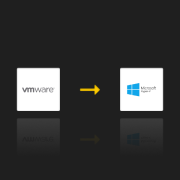
Virtual Machine Backup – A Step-by-Step Guide to Data Protection
Virtualization has become the cornerstone of modern IT environments, enhancing infrastructure efficiency and flexibility. However, ensuring data security and business continuity is paramount. Virtual machine (VM) backup is an essential component of any organization’s data protection strategy. In this article, we’ll guide you through implementing an effective VM backup step-by-step.
What is Virtual Machine Backup?
Virtual Machine (VM) backup is the process of creating a secure copy of a virtual machine’s data, configuration, and system state to safeguard against data loss caused by disasters, hardware failures, or software corruption. It is a critical component of data protection strategies for businesses utilizing virtual environments, ensuring operational continuity and minimizing downtime.
VM backup solutions enable the capture and storage of virtual machine data in a way that allows quick and efficient restoration when needed. Backups can be created using various methods, including:
- Full backups, which replicate the entire virtual machine;
- Incremental backups, which save only the changes made since the last backup;
- Differential backups, which save changes made since the last full backup.
Modern VM backup software offers advanced features such as data deduplication, which eliminates duplicates to save storage space; compression, which reduces the size of backup files; and encryption, which secures sensitive data against unauthorized access.
By implementing VM backups, businesses can effectively protect their virtual environments, ensuring resilience to unexpected disruptions and maintaining operational stability.
What is a Hypervisor?
A hypervisor is a core component of IT infrastructure that enables virtualization—the process of creating virtual environments, such as virtual machines, commonly used in cloud computing. It can be a piece of hardware, machine code, or software that manages the virtualization of physical resources, allowing for efficient use of available assets.
The computer running the hypervisor is referred to as the “host,” while the virtual machines created on it are known as “guests.” The hypervisor acts as an intermediary layer, separating physical components such as the processor, RAM, and storage from the virtual machines. This ensures that each virtual machine operates independently, utilizing its allocated resources, thereby enabling efficient IT management and simultaneous execution of multiple tasks.
Types of Hypervisors
Based on their operation and integration with physical infrastructure, hypervisors are categorized into:
-
Type 1 Hypervisors (Bare-Metal):
Operate directly on physical hardware, delivering high performance and stability. Examples: VMware ESXi, Microsoft Hyper-V, Xen. -
Type 2 Hypervisors (Hosted):
Installed as applications on an operating system, making them easier to set up but less efficient. Examples: VMware Workstation, VirtualBox.
Popular Hypervisors
| Name | Description |
|---|---|
| VMware vSphere | A popular enterprise-class hypervisor for running virtual machines. |
| Microsoft Hyper-V | Microsoft’s virtualization solution for business environments. |
| Cloud-Based Hypervisors | Hypervisors hosted in data centers, providing scalability and resilience. |
Hypervisors like VMware vSphere and Microsoft Hyper-V are among the most widely used solutions in corporate environments. They offer stable platforms for running virtual machines, supporting optimal resource utilization and operational reliability.
Additionally, cloud-based hypervisors enable the deployment of virtual machines in data centers, allowing organizations to leverage cloud infrastructure for increased scalability and resilience.
By adopting these technologies, organizations can maximize hardware efficiency, reduce operational costs, and gain flexibility in managing their IT environments, making hypervisors the cornerstone of modern virtualization solutions.
Why Use Virtual Machine Backup Software?
To safeguard virtual machines and ensure their reliability, specialized VM backup software is essential. These tools enable comprehensive backup and recovery processes, covering all files that make up a virtual machine, including data, configurations, and system state. This ensures that an entire virtual machine can be restored when needed. It is a crucial component of a business continuity strategy, minimizing downtime and preventing data loss that could jeopardize business operations.
Benefits of VM Backup
Protecting critical business workloads, virtual machines, and their data is vital for a company’s survival. Data backups act as a safety net against loss or corruption, enabling swift recovery after unexpected events. In today’s digital age, data and applications drive business growth—losing them can directly impact productivity and profitability. VM backup ensures business continuity, minimizing downtime and allowing rapid restoration of operations in the event of data loss or system failure. This level of protection is essential for maintaining customer trust and operational stability.
How to Choose the Right VM Backup Software
Protecting a VMware environment requires reliable backup software that integrates with vSphere and fully supports VMware features. Xopero Backup for Virtual Machines is a comprehensive tool that ensures stable backups – essential for business continuity and protection against threats such as ransomware.
By utilizing vStorage APIs for Data Protection (VADP), Xopero enables fast backups and efficient data recovery in VMware environments. The backup process has minimal impact on the operation of virtual machines, helping to avoid downtime and maintain their integrity.
When choosing VM backup software, it’s worth considering a few key aspects:
- Hypervisor compatibility: Ensure the solution supports your hypervisor, such as VMware vSphere or Microsoft Hyper-V.
- Scalability and performance: Select software that grows with your business without negatively affecting performance.
- Backup types: Look for a solution that supports full, incremental, and differential backups to flexibly adapt the data protection process to your needs.
Features to look for:
- Incremental and application-consistent backups: Incremental backups reduce disk space usage and shorten operation time, while application-consistent backups ensure data integrity, especially for critical applications.
- Ease of use: An intuitive interface and simple management save time and improve efficiency in daily operations.
When evaluating backup solutions, remember that effective data protection should combine performance with reliability, ensuring secure data storage and easy access in case of need. Xopero Backup meets these needs, helping you optimize data protection processes for your business.
VMware Backup
To effectively protect your VMware environment, you need a backup solution that integrates with vSphere and fully supports VMware features. Xopero Backup for Virtual Machines is a tool that delivers reliable backups, essential for ensuring business continuity and protection against ransomware attacks.
One of the best practices is to use a backup agent in the ESX service console to achieve efficient and consistent backups. Additionally, utilize VMware Consolidated Backup (VCB) to offload VM backup tasks from the ESX server, reduce server load, and improve overall performance.
Another approach is to use vStorage APIs for Data Protection (VADP). Designed to provide efficient backup and recovery in VMware environments, VADP minimizes the impact on virtual machines during backup operations. By following these best practices, you can optimize your backup process, reduce downtime, and maintain VMware virtual machines in a consistent state.
Virtual Machine Backup Methods
There are several methods to create backups of virtual machines, each with its own advantages and disadvantages. One approach is to use a local backup agent within each virtual machine for more granular backup control. Another option is to deploy a backup agent in the ESX service console to enhance backup efficiency.
VMware Consolidated Backup (VCB) is another method that offloads virtual machine backup tasks from the ESX server, freeing up resources and improving performance. Modern virtual machine backup software leverages advanced features available in hypervisors, such as vStorage APIs, to enhance backup performance and minimize the impact on the virtual environment. These methods give you the flexibility to choose an approach that meets your backup and recovery needs, including incremental backups that capture all changes since the last full or incremental backup, optimizing storage space and simplifying version control.







